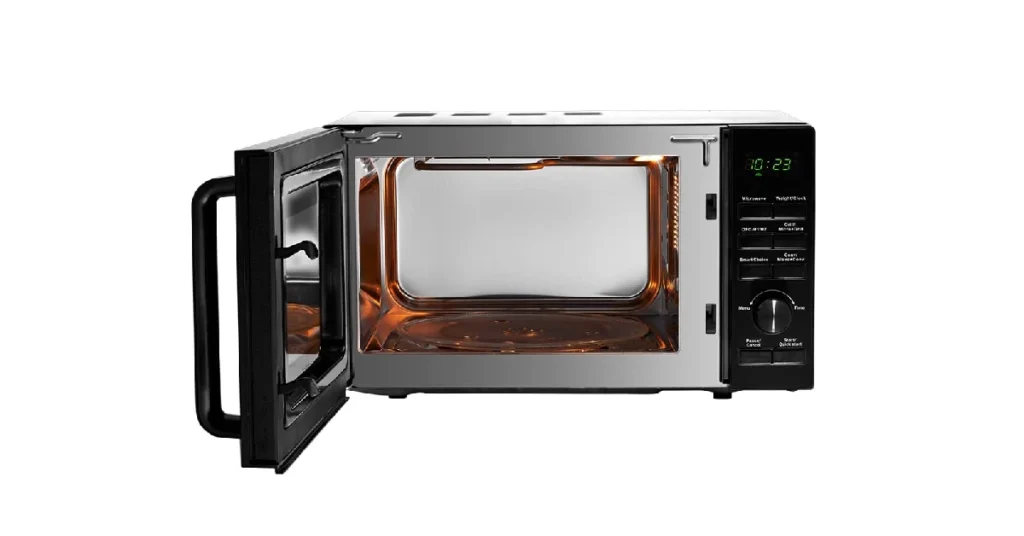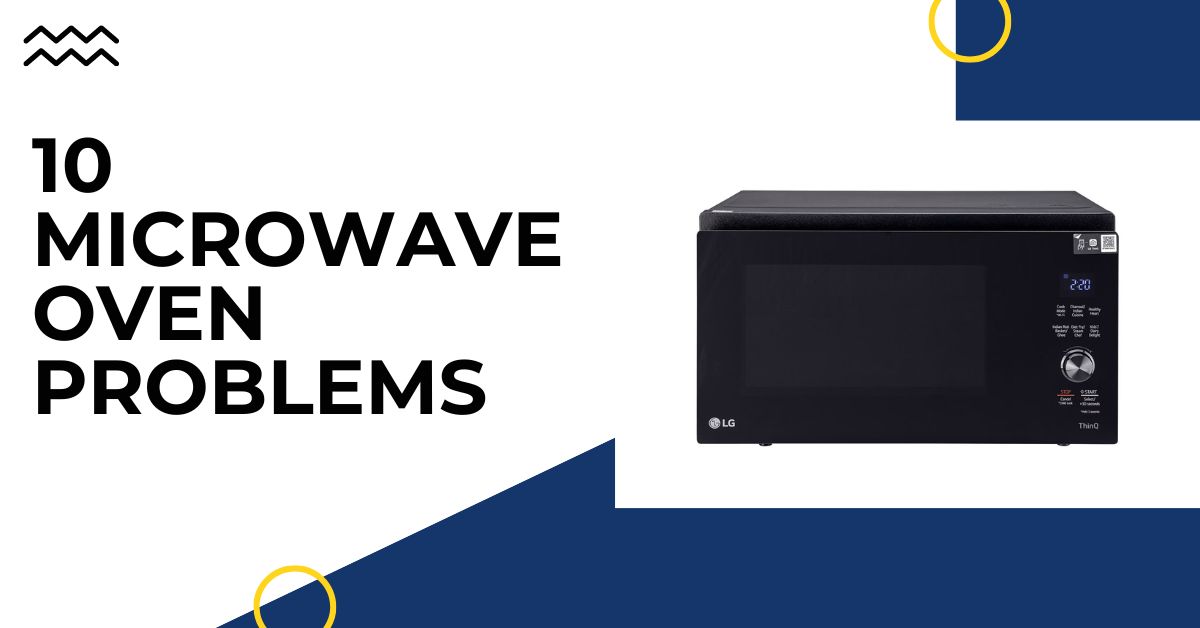Microwave ovens have become essential household devices due to their convenience and efficiency in meal preparations.
However, like other appliances, they can encounter different issues over time.
This comprehensive guide will describe the most typical microwave oven problems, their causes, and how to solve them practically.
After reading this article you will be able to troubleshoot and fix many of the issues your microwave may face, making it last longer and operate at its best.
Also read: LG 32L WiFi Enabled Charcoal Microwave Oven.

#1. One of the common microwave oven problems is when it won’t turn on.
One of the most frustrating problems is when your microwave oven won’t turn on. This issue can stem from various causes.
#1. Possible Causes and Solutions.
#1. Power Supply Issues:
Make sure that the microwave is plugged into an outlet that works properly. Inspect the circuit breaker or fuse box for any tripped breakers or blown fuses.
- Solution: Reset the circuit breaker or replace the fuse.
#2. Door Switch Problems:
The door not fully closed or a faulty door switch are reasons why your microwave won’t start.
- Solution: Inspect the door latch and switch. Replace if necessary.
#3. Thermal Fuse:
A blown thermal fuse can prevent the microwave from operating.
- Solution: Find and change the thermal fuse.
#4. Control Board Issues:
The control board could be defective.
- Solution: Check the control board and replace it when it’s malfunctioning.
Also read: Differences Between Microwave and Oven.
#2. Microwave Runs But Doesn’t Heat
When a microwave runs but does not heat things then there might be a problem with one of its internal components.
Possible Causes and Solutions
#1. Magnetron Failure:
The microwave’s magnetron is the one that provides its heat. If the magnetron is defective, then your microwave won’t produce any heat at all.
- Solution: Replace the magnetron.
#2. High Voltage Diode:
The high voltage diode changes AC power to DC power that can be used by the magnetron. If it fails, your microwave will not cook.
- Solution: Test and replace the high-voltage diode.
#3.Capacitor:
Also, a broken capacitor cannot allow you to warm food in your household appliance.
- Solution: Test and replace the capacitor if necessary.
Also read: Solo vs Convection Microwave Oven.
#3. Microwave Plate Not Spinning.
When a microwave plate stops spinning, it may affect even cooking of foods.
Possible Causes and Solutions
#1. Turntable Motor:
A motor situated beneath the microwave that rotates the turntables could be broken down.
- Solution: Test the motor and replace it if it’s defective.
#2. Roller Guide:
Either a misaligned or damaged roller guide that holds up the turntable
- Solution: Adjust or replace the roller guide.
#3. Control Board:
Supposing there happens to be no control board failure, signals from this spin might not be sent.
- Solution: Inspect the control board and replace it if needed.
Also read: What is the difference between OTG and Microwave?
#4. Microwave Making Strange Noises.
Good and functioning microwaves should operate almost silently. Some strange noises indicate trouble somewhere in them.
Possible Causes and Solutions
#1. Turntable Motor:
Buzzing or grinding noise may indicate a failing motor.
- Solution: Replace the turntable motor.
#2. Magnetron:
Similarly, a noisy humming sound might result from a faulty magnetron itself.
- Solution: Replace the magnetron.
#3. Fan:
Defective cooling fan or stirrer motor.
- Solution: Check and replace the fan or motor if necessary.
Also read: How to Use a Microwave Oven.
#5. Microwave Door Won’t Close Properly
If the microwave door does not shut properly, this may keep it from switching on.
Possible Causes and Solutions
#1. Door Latch Assembly:
Misaligned or broken door latch.
- Solution: Realign or replace the door latch assembly.
#2. Hinges:
Broken hinges on doors
- Solution: Tighten or replace the hinges.
#3. Door Switch:
Non-latching door as a result of faulty door switch.
- Solution: Replace the door switch.
Also read: How to Clean a Microwave Oven.
#6. Microwave Display Not Working
If your microwave’s display goes out, you will not be able to set times and modes for cooking; this can cause tremendous inconvenience.
Possible Causes and Solutions
#1. Control Board: It is the control board that mostly malfunctions.
- Solution: Inspect and replace the control board if necessary.
#2. Display Panel: The panel in the display itself may be faulty.
- Solution: Replace the display panel.
#3. Wiring: There might be loose or broken wire connections.
- Solution: Check the wiring connections and secure or replace them as needed.
Also read: Top 10 Best Convection Microwave Ovens in India.
#7. Microwave Buttons Not Working
If you experience unresponsive buttons on your microwave, it will disable its intended use.
Possible Causes and Solutions
#1. Control Board:
A damaged control board might fail to send signals to any part of the microwave components.
- Solution: Replace the control board.
#2. Membrane Switch:
Below the button panel, there could be a failure of the membrane switch.
- Solution: Replace the membrane switch.
#3. Touchpad:
The touchpad may also have been spoiled.
- Solution: Replace the touchpad.
Also read: What is a Convection Microwave?
#8. Microwave Sparks or Arcs
When you see sparks or arcs inside your microwave then something needs to be done instantly as this can be dangerous.
Possible Causes and Solutions
#1. Metal Inside Microwave:
Anything made from metal inside a microwave unit is capable of causing sparks when heated in it.
- Solution: Remove any metal objects.
#2. Waveguide Cover:
Sparks occur when the waveguide cover gets spoiled or dirty while in operation.
- Solution: Clean or replace the waveguide cover.
#3. Diode:
Arcing takes place if there is a defective high-voltage diode.
- Solution: Replace the diode.
Also read: LG 32L WiFi Enabled Charcoal Microwave Oven.
#9. Microwave Smells Like Burning.
In case your microwave oven smells like it is burning, it could signal various problems that require immediate attention by specialists.
Possible Causes and Solutions
#1. Food Residue:
Burnt food particles give off a burning smell.
- Solution: Clean the interior thoroughly.
#2. Electrical Components:
Electrical components overheating may also emit burning smells as well
- Solution: Unplug the power cord from the outlet socket and check for visible signs of damage. If necessary consult a professional electrician for advice.
#3. Turntable Motor:
A failing turntable motor can overheat and emit a burning smell.
- Solution: Replace the turntable motor.
#10. Microwave Door Glass Cracked
A cracked door glass can be dangerous and requires immediate attention.
Possible Causes and Solutions
#1. Physical Impact:
A physical blow might shatter the glass.
- Solution: Replace the microwave door or the glass pane.
#2. Heat Stress:
If the glass is exposed to high heat for long, it will eventually break.
- Solution: Change the door glass and avoid keeping hot things right next to the glass.
Maintenance Tips for Preventing Microwave Problems.
Various ways can be used to maintain your microwave oven. The following tips might help you:
#1. Clean Regularly:
Ensure that both the interiors and exteriors of your microwave remain clean so that there is no accumulation of food and hence prevent fire accidents.
#2. Avoid Metal:
Avoid placing any metallic object inside your microwave as this may cause sparks and damage to the oven itself.
#3. Check Door Seals:
Make sure that the door closes properly so that air does not escape from it when cooking or reheating meals in a microwave oven.
#4. Use Microwave-Safe Containers:
To avoid endangering life, always look for containers with “microwave-safe” on them rather than putting any other material into them.
#5. Inspect Components:
Regularly check elements like a turntable, roller guide, waveguide cover, etc., for wearing out signs or any other defect.
FAQs
What is the most common cause of microwave failure?
A weak magnetron is the most common reason microwaves cease to work. When it fails, your microwave may keep running but there will be no heating effect. You can identify this problem when the microwave starts but keeps cold inside. Replacing it often solves this problem, though in some cases it could be more economical to replace the entire unit especially if it’s aged.
What are 5 disadvantages of using a microwave?
Microwaves offer convenience, but they come with some drawbacks:
1. Nutrient Loss: Some vitamins and other nutrients degrade when subjected to the high temperature used in microwave cookery which results in meals with low nutritive value.
2. Uneven Heating: Microwaves often heat food unevenly, leaving some parts too hot and others cold, which can affect food safety and taste.
3. Texture Changes: Foods that are meant to be crispy like bread or fried items tend to come out soft or rubbery after being reheated using a microwave.
4. Limited Cooking Techniques: Microwaves are great for reheating and basic cooking but cannot perform more complex cooking techniques such as browning, caramelizing, or baking.
5. Radiation Concerns: Some people worry about the potential long-term impacts of being exposed to microwave radiation; especially if their appliances are old or damaged although they are generally considered safe.
What are the safety issues with microwave ovens?
Microwave ovens are generally safe, but there are some important safety issues to be aware of:
1. Radiation Leakage: If a microwave’s door or seals are defective, there is a possibility that the microwave radiation will escape, which is dangerous. Always make sure that the door of your microwave closes tightly and is in good repair.
2. Burn Risks: The uneven heating can create hot spots in food, especially liquids, leading to burns when consumed or spilled.
3. Fire Hazards: Sparks may ignite fires inside microwaves by placing metal objects or using non-microwave-safe containers.
4. Exploding Foods: Some foods like eggs or sealed containers pop if you put them into the microwave due to pressure buildup.
5. Electric Shocks: Thus, water spills and defective wiring can cause electric shocks; therefore it is necessary to ensure that moisture does not get into the oven and its environment remains dry.
What is the problem of microwave oven noise?
Microwave oven noise can be a sign of underlying issues:
Turntable Motor Issues: The turntable produces an irritating noise like grinding or loud humming. When this happens, you may have to replace the motor of your turntable to restore its previous silence.
Magnetron Problems: The noise can come from the magnetron which may lead to a heating malfunction eventually. A technician must check any buzzing or humming sounds from this part.
Cooling Fan Troubles: A damaged fan for cooling can also make strange noises while trying to maintain a microwave’s internal temperature. It might necessitate replacement of the same.
Loose Components: In due course, screws and other internal parts get loose causing rattling sounds. This problem can be solved by tightening up or substituting such parts.
General Wear and Tear: With time, internal components wear and tear out and make old microwaves louder. Regular maintenance helps reduce noise levels.
Conclusion
For many years now, microwave ovens have proved to be very useful kitchen tools; however, they too face different microwave oven problems over time.
By getting familiar with common problems encountered in microwaves as well as their solutions, you can solve most of these problems by yourself at home.
Regular maintenance and correct use will also extend its lifespan while making it work efficiently.
Feel free to share your views below and, if you find it helpful, don’t hesitate to spread the word with others.










